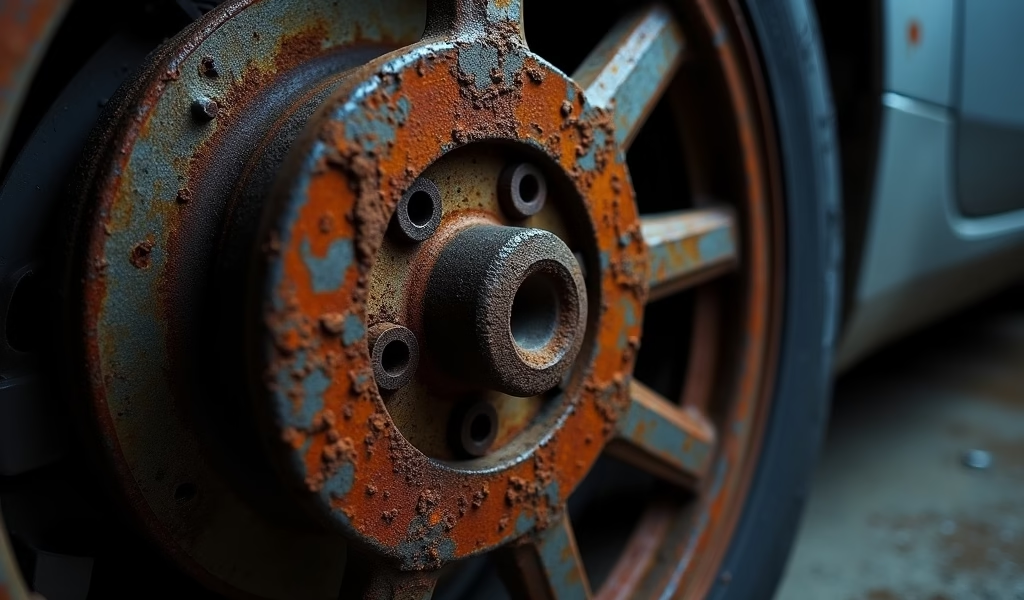Overview
This article provides five essential strategies for protecting alloy wheels from corrosion: regular cleaning with proper products, applying protective sealants, considering professional ceramic coatings, promptly repairing damage, and implementing special winter protection measures. The author emphasizes that consistent maintenance prevents costly wheel replacement and preserves both appearance and structural integrity, especially in harsh conditions with exposure to road salt and brake dust.
Table of Contents
- Understanding Alloy Wheel Corrosion
- Causes of Alloy Wheel Corrosion
- Tip 1: Regular Cleaning and Maintenance
- Tip 2: Apply Protective Sealants and Waxes
- Tip 3: Consider Professional Wheel Coating
- Tip 4: Promptly Repair Any Damage
- Tip 5: Special Winter Protection Measures
- Conclusion
- Frequently Asked Questions
Understanding Alloy Wheel Corrosion
Alloy wheel corrosion protection is something I wish more drivers took seriously. In my 15 years working as an automotive technician, I’ve seen countless beautiful wheels ruined by corrosion that could have been prevented with some basic care. Those shiny alloy wheels that enhance your vehicle’s appearance aren’t just about looks – they’re an investment worth protecting.
Alloy wheels are typically made from aluminum combined with other metals like magnesium to create a lightweight, strong material. While they offer performance benefits like improved heat dissipation and reduced unsprung weight, they’re unfortunately susceptible to corrosion. The oxidation process occurs when the metal is exposed to moisture, road salt, and harsh chemicals, leading to those unsightly white or crusty patches that can eventually compromise the wheel’s integrity.
Unlike steel wheels with hubcaps, alloy wheels are constantly exposed to the elements. Without proper protection, even premium wheels can begin showing signs of corrosion within a few years, especially in areas with harsh winters or coastal environments where salt exposure is high. That’s why implementing an effective alloy wheel corrosion protection strategy isn’t just about aesthetics – it’s about preserving your wheels’ structural integrity and resale value.
Causes of Alloy Wheel Corrosion
Before diving into protection strategies, it helps to understand what we’re fighting against. Several factors accelerate the corrosion process in alloy wheels:
Road salt is perhaps the most aggressive culprit. During winter, municipalities spread salt to melt ice, and this highly corrosive substance splashes onto your wheels and clings to surfaces. The salt creates an electrolyte that accelerates the oxidation process, particularly damaging for aluminum alloys. I’ve seen wheels that look years older after just one harsh winter without proper protection.
Brake dust is another significant factor. When you brake, tiny metal particles from your brake pads and rotors mix with heat and moisture to create a corrosive compound that bonds to your wheels. This mixture is particularly damaging because it contains metal particles that can cause galvanic corrosion when they contact your alloy wheels. The wheel weight balancing process can be affected if corrosion becomes severe, creating uneven surfaces.
Environmental factors also play a major role. Living near the coast exposes your wheels to salt air, while industrial areas may have higher levels of acid rain or air pollution that accelerate corrosion. Even regular exposure to puddles, rain, and high humidity can trigger oxidation if wheels aren’t properly sealed and protected.
Finally, wheel damage from curb strikes or potholes can chip the protective clear coat or paint on alloy wheels. These breaches in the wheel’s protective layer create entry points for moisture and corrosive substances to attack the bare metal beneath. As a mechanic, I often see corrosion starting precisely at these damage points.

Tip 1: Regular Cleaning and Maintenance
The foundation of effective alloy wheel corrosion protection is consistent, proper cleaning. I recommend cleaning your wheels at least every two weeks, and more frequently during winter months when road salt is prevalent. Don’t wait until your wheels look dirty – by then, corrosive substances have already been at work.
Start with the right cleaning products. Avoid household detergents or acidic cleaners that can strip protective finishes and accelerate corrosion. Instead, invest in pH-neutral wheel cleaners specifically formulated for alloy wheels. These products effectively remove brake dust and road grime without damaging the wheel’s finish or protective coatings. Consumer Reports recommends dedicated wheel cleaners as they’re designed to remove stubborn contaminants safely.
The cleaning technique matters just as much as the products. Here’s my recommended process:
- Rinse wheels thoroughly with water to remove loose debris
- Apply wheel cleaner according to product instructions, typically allowing it to dwell for 2-5 minutes
- Use soft-bristled brushes to clean between spokes and around lug nuts – never use wire brushes that can scratch the finish
- Pay special attention to the barrel (inner portion) of the wheel where brake dust accumulates
- Rinse thoroughly with clean water, ensuring all cleaning product is removed
- Dry completely with a microfiber towel to prevent water spots and lingering moisture
For wheels with existing light corrosion, you might need specialized aluminum wheel polishes that can safely remove oxidation. Apply these products with a microfiber cloth, working in small sections. The wheel diameter measurements can help you select the right size cleaning tools for your specific wheels.
Remember that the barrel and back of the wheel often corrode first because they’re harder to clean and more exposed to brake dust. Make the effort to clean these areas thoroughly – a wheel brush with a long handle can help reach these difficult spots.
Tip 2: Apply Protective Sealants and Waxes
Once your wheels are clean, the next crucial step in alloy wheel corrosion protection is applying a protective barrier. Think of this as sunscreen for your wheels – a layer that shields the alloy from corrosive elements. In my professional experience, this step makes the difference between wheels that still look new after years and those that succumb to corrosion.
Wheel sealants and waxes create a hydrophobic barrier that repels water, salt, and brake dust rather than allowing these substances to bond with the wheel surface. This not only protects against corrosion but also makes future cleaning much easier as contaminants don’t adhere as strongly.
For maximum protection, I recommend using a dedicated wheel sealant rather than automotive wax. Wheel-specific sealants are formulated to withstand the high temperatures generated by brakes and provide longer-lasting protection. Some premium ceramic wheel coatings can provide protection for up to 12 months, while traditional wheel waxes typically last 1-3 months.
Application is straightforward but requires attention to detail:
- Ensure wheels are completely clean and dry before application
- Apply a small amount of sealant to an applicator pad
- Work in small sections, covering all visible surfaces including between spokes
- Allow the product to haze over (typically 5-10 minutes)
- Buff off with a clean microfiber cloth
- Don’t forget the barrel and back of the wheel if accessible
For optimal protection, reapply sealant every three months, or more frequently in harsh climates. I find that many drivers overlook this maintenance step, assuming a one-time application provides permanent protection. Regular reapplication is essential for maintaining the protective barrier, especially after winter or periods of heavy rain.
Some wheel sealants also add a beautiful glossy finish that enhances the appearance of your alloy wheels while protecting them. This is particularly noticeable on wheels with machined or polished faces. The wheel rim width compatibility should be considered when selecting cleaning and sealing tools to ensure proper coverage.
Tip 3: Consider Professional Wheel Coating
For those seeking the ultimate in alloy wheel corrosion protection, professional-grade ceramic coatings offer exceptional durability and protection. Unlike DIY sealants, these coatings chemically bond with the wheel’s surface to create a semi-permanent barrier that can last years rather than months.
Professional ceramic coatings like Gtechniq C5 or CarPro DLUX create an incredibly hard, glass-like surface that provides superior resistance to brake dust, road salt, and environmental contaminants. Research published in Materials Today shows that ceramic coatings can significantly enhance corrosion resistance of aluminum alloys.
These coatings can be applied by a professional detailer or, in some cases, by a careful DIY enthusiast. The process typically involves:
- Professional wheel cleaning and decontamination
- Polishing to remove any existing oxidation or imperfections
- Application of a primer or base coat
- Application of the ceramic coating
- Curing period (often 24 hours)
The cost for professional application typically ranges from $50-150 per wheel, depending on wheel size, design complexity, and the specific coating used. While this represents a significant investment, it can be cost-effective when you consider the extended protection period (often 2+ years) and the potential cost of wheel refurbishment or replacement due to corrosion damage.
For those who prefer a professional-grade solution without the professional price tag, consumer-grade ceramic wheel coatings are available. These products offer a middle ground between traditional sealants and professional coatings, typically lasting 6-12 months with proper application and maintenance.
I’ve seen remarkable differences in wheel condition between vehicles with ceramic-coated wheels and those without, especially after several years. The coating’s ability to resist high temperatures and harsh chemicals makes it particularly well-suited for alloy wheel protection.

Tip 4: Promptly Repair Any Damage
In my years working as a mechanic, I’ve seen how quickly corrosion can spread from a small chip or scratch in an alloy wheel. That’s why prompt repair of any damage is a crucial component of effective alloy wheel corrosion protection.
When your wheel sustains damage from a curb strike, pothole impact, or even just a rock chip, the protective clear coat or paint is compromised. These breaches expose the bare aluminum alloy to the elements, creating an entry point for moisture and corrosive substances. Once corrosion begins in these areas, it can spread under the remaining finish like a cancer.
For minor scratches and chips, touch-up paint designed specifically for alloy wheels can provide adequate protection if applied properly. The process involves:
- Cleaning the damaged area thoroughly
- Gently sanding the area to remove any loose material
- Applying a small amount of wheel touch-up paint
- Allowing it to dry completely
- Applying a clear protective coat
For more significant damage or wheels with extensive corrosion, professional refurbishment may be necessary. This typically involves:
- Stripping the wheel down to bare metal
- Repairing structural damage (if present)
- Treating any existing corrosion
- Repainting or powder coating
- Applying a protective clear coat
Professional wheel refurbishment typically costs between $100-300 per wheel depending on wheel size, damage extent, and finish type. While not inexpensive, it’s far more cost-effective than replacing premium alloy wheels, which can cost $300-1000+ each for OEM wheels.
Even if you plan to have wheels professionally refurbished eventually, applying touch-up paint to damage points in the interim can prevent corrosion from taking hold and spreading. Think of it as a temporary bandage that prevents infection until proper treatment can be applied.
Many drivers make the mistake of ignoring minor wheel damage because it seems cosmetic. However, from a corrosion protection standpoint, even small breaches in the wheel’s protective finish deserve immediate attention to prevent more serious issues down the road.
Tip 5: Special Winter Protection Measures
Winter presents the greatest challenge for alloy wheel corrosion protection. The combination of road salt, moisture, and temperature fluctuations creates the perfect storm for accelerated corrosion. Having worked in areas with harsh winters, I’ve developed specific strategies to help wheels survive these challenging months.
Before winter arrives, apply a heavy-duty wheel sealant or consider a winter-specific wheel wax that’s formulated to provide enhanced protection against salt and brine solutions. Some products contain additional polymers and synthetic waxes that adhere more strongly in cold conditions and provide superior salt resistance.
Increase your wheel cleaning frequency during winter months. Even when it seems futile due to roads being constantly salty, washing away these corrosive substances before they can do damage is crucial. Aim for weekly cleaning when conditions allow, even if it’s just a thorough rinse at a self-service car wash. NHTSA recommends regular washing during winter months to prevent salt damage to vehicles.
Consider these additional winter protection strategies:
- Use touchless car washes when temperatures are below freezing to avoid frozen door locks and windows
- After washing, drive the vehicle briefly to help dry the wheels and brake components
- If available in your area, visit car washes that include an underbody flush to remove salt from wheel wells
- Apply an extra layer of wheel sealant mid-winter if possible
- For areas with extremely harsh winters, consider switching to steel winter wheels with winter tires
That last point deserves elaboration: dedicated winter wheels are a serious consideration for those in areas with heavy salt usage. While it requires an initial investment, a set of steel wheels for winter use can preserve your alloy wheels from the worst conditions. Modern steel wheels are far more attractive than those of decades past, and the peace of mind knowing your expensive alloys are safely stored is valuable.
For those who must use their alloy wheels year-round, pay special attention to the lug nut seats and center bore of the wheel during winter months. These areas can trap salt and moisture, leading to corrosion that may make wheel removal difficult in the future. A light coating of anti-seize compound on the center bore (not on lug studs or nuts) can help prevent this issue.
Remember that temperature fluctuations around freezing are particularly problematic, as the freeze-thaw cycle can force moisture into microscopic cracks in the wheel’s protective finish. This makes proper sealing before winter and regular cleaning during winter all the more important.
Conclusion
Effective alloy wheel corrosion protection isn’t complicated, but it does require consistency and attention to detail. By implementing these five key strategies – regular cleaning, applying protective sealants, considering professional coatings, promptly repairing damage, and taking special winter precautions – you can significantly extend the life and appearance of your alloy wheels.
I’ve seen firsthand how these simple practices make a dramatic difference in wheel condition over time. Vehicles that come into my shop with a history of proper wheel care typically have alloys that look nearly new even after many years of service, while neglected wheels often show significant corrosion within just a few seasons.
Remember that protection is always easier and less expensive than restoration. A few minutes spent cleaning and protecting your wheels every few weeks can save hundreds of dollars in refurbishment costs down the road. Plus, well-maintained wheels enhance your vehicle’s appearance and can positively impact its resale value.
Whether you’re driving a luxury vehicle with premium alloys or a daily driver with basic aluminum wheels, these protection strategies apply equally. Your wheels represent both a functional component and an aesthetic element of your vehicle – they deserve care that addresses both aspects.
By making alloy wheel corrosion protection part of your regular vehicle maintenance routine, you’ll enjoy better-looking wheels, avoid costly repairs, and potentially even enhance your vehicle’s safety by preventing structural wheel issues that can develop from unchecked corrosion.
Frequently Asked Questions
How often should I clean my alloy wheels to prevent corrosion?
Clean your alloy wheels every 1-2 weeks in normal conditions, and weekly during winter or in coastal areas. Regular cleaning prevents corrosive substances from having time to damage the wheel surface.
Can I use household cleaners on my alloy wheels?
No, avoid household cleaners as they often contain harsh chemicals that can damage protective coatings. Use pH-neutral cleaners specifically formulated for alloy wheels.
How long do wheel sealants typically last?
Standard wheel sealants typically last 1-3 months, while ceramic coatings can protect for 6-24 months. Reapplication frequency depends on driving conditions and exposure to harsh elements.
Is it worth getting professional ceramic coating for alloy wheels?
Yes, professional ceramic coatings provide superior protection lasting 2+ years and are worth considering for expensive wheels or vehicles in harsh environments. The investment pays off through extended wheel life and reduced maintenance.
Can corrosion affect the structural integrity of alloy wheels?
Yes, severe corrosion can compromise the structural integrity of alloy wheels, potentially creating safety hazards. This is particularly concerning around lug nut seats and the center bore where wheel mounting integrity could be affected.

